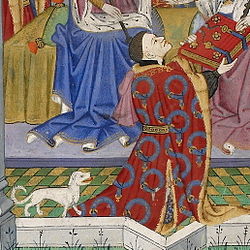John Talbot | |
|---|---|
| 1st Earl of Shrewsbury | |
 Detail of illuminated miniature from the Talbot Shrewsbury Book showing John Talbot, 1st Earl of Shrewsbury, KG, identified by a talbot dog, presenting the book to Margaret of Anjou, Queen of England, 1445. His robe displays several encircled Garters. | |
| Tenure | 20 May 1442 – 17 July 1453 |
| Other titles |
|
| Known for | Military activity during the Hundred Years' War |
| Born | c. 1387 Blackmere castle, Shropshire 52°58′40″N 2°39′24″W / 52.97767°N 2.65680°W |
| Died | 17 July 1453 (aged 65–66) Castillon-la-Bataille, Gascony |
| Cause of death | Slain in battle |
| Buried | St Alkmund's Church, Whitchurch |
| Offices | Lieutenant of Ireland Lord High Steward of Ireland Constable of France |
| Spouse(s) |
|
| Issue | |
| Occupation | Soldier |
| Military career | |
| Allegiance | |
| Service | English army |
| Years of service | 1404–1453 |
| Conflicts |
|


John Talbot, 1st Earl of Shrewsbury, 1st Earl of Waterford, 7th Baron Talbot, KG (c. 1387 – 17 July 1453), known as "Old Talbot", was an English nobleman and a noted military commander during the Hundred Years' War. He was the most renowned in England and most feared in France of the English captains in the last stages of the conflict. Known as a tough, cruel, and quarrelsome man,[1] Talbot distinguished himself militarily in a time of decline for the English. Called the "English Achilles" and the "Terror of the French", he is lavishly praised in the plays of Shakespeare. The manner of his death, leading an ill-advised charge against field artillery, has come to symbolize the passing of the age of chivalry.[2] He also held the subsidiary titles of 10th Baron Strange of Blackmere and 6th Baron Furnivall jure uxoris.
- ^ Pollard 2015, p. 835.
- ^ Pollard 2004.